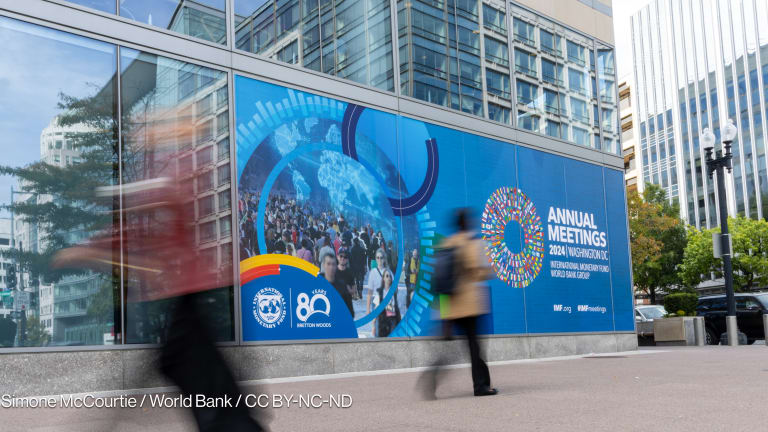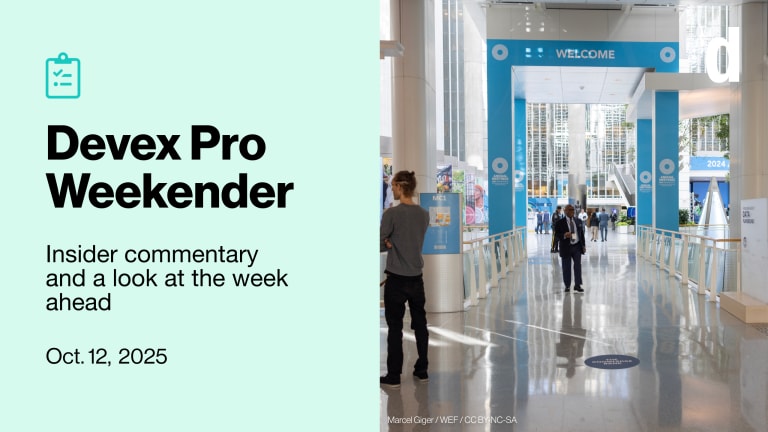Will the World Bank-IMF meetings try to fly under the political radar?
With the annual meetings around the corner, Clemence Landers of the Center for Global Development and David McNair of ONE reflect on the World Bank's keep-your-head-down agenda.
The World Bank-International Monetary Fund annual meetings are always closely watched for any big announcements and, perhaps even more importantly, any hints about the trajectory of their priorities and agenda. This year, though, the agenda, while still emphasizing traditional priorities such as jobs, may be a quieter, more subdued one — a reaction to the tenuous relationship that multilateral institutions, such as the World Bank, have with a multilateral-averse administration that’s hyper-focused on U.S. President Donald Trump’s “America First” policies. “Stealth mode” is how Clemence Landers described the bank’s approach to this year’s annual meetings at a Devex Pro Briefing on Wednesday. “There’s not that vibrant reform agenda around evolution that we saw this time last year,” Landers, vice president and senior policy fellow at the Center for Global Development, told Devex. “We’re now much more in a defensive posture where the organizations aren’t talking about things like climate and gender, and really trying to go under the radar and to figure out an agenda that can please this administration.” “Back to basics” and “returning to the core mission” are how fellow panelist David McNair, executive director at ONE, described the World Bank’s approach to the narrative surrounding this year’s meetings. “Don’t say very much. Just get on with it,” he said. “I’d be surprised if there’s an effort to … bang the drum on what are seen as kind of divisive issues, when you could just kind of quietly get the work done, have the same outcomes, and not jeopardize political support for these things. And so I think that’s probably a kind of a pragmatic and probably quite a smart approach that the institutions are taking.” “Even though the rhetoric around … climate and gender and so on aren’t being discussed, I think there is a lot of action happening under the radar,” McNair added, citing the Mission 300 joint endeavor between the World Bank and African Development Bank to connect 300 million people in sub-Saharan Africa to electricity by 2030. “In a sense, the language has changed, but the core operations may not have changed that much, and that’s probably a positive thing,” he said. Landers also pointed out that the bank is demand-driven, not supply-driven, and there is clear demand for climate-related projects. “So if countries go to the bank and say, ‘This is what I want to borrow for’ — that tends to be what the World Bank then lends for. So a lot of the future of the World Bank’s climate finance really rests on there being sustained demand for climate financing, and we are seeing very robust demand for climate financing,” she said. And while geopolitics are sure to play a role in that type of financing, if a climate investment makes economic sense, its chances of moving forward are that much stronger. “When you’re looking at investments … that create jobs, that are also investing in the green economy as a route to economic transformation, that’s where there’s a kind of Venn diagram of these things working together, and that's probably where the investment should be made in any case,” McNair said. That’s especially true when talking about jobs — the watchword of World Bank President Ajay Banga. His focus on job creation inevitably translates into a focus on bringing in the private sector to create those jobs — which in turn conjures up cringy memories of the overhyped “billions to trillions” mantra that billions in public sector money could catalyze trillions of dollars in private sector investment. “There’s a lot of emphasis that’s being placed on the private sector agenda,” Landers said. “There’s a live debate as to how well this really works in practice. But I don’t think this debate and this agenda is going away anytime soon, and I especially think when … you have a lot of aid cuts, you have a lot of development dollars that are going to disappear from the system, that billions to trillions — to bring back that slightly zombie term — is going to be much more prevalent again in the public discourse.” She noted that to entice the private sector, the World Bank needs to become less risk-averse. That includes allowing the bank’s private sector arm, the International Finance Corporation, “to do more first-loss investments in equity. So far, the IFC has done very little equity — I think it’s something like 2% of its portfolio. There’s a lot of conviction around the fact that’s sort of one of the really missing pieces in development finance — is more risk on the equity side,” she said. Getting creative with bringing down the cost of capital is another way to appeal to investors and governments alike. Landers cited the example of a syndicated loan to Côte d’Ivoire that was guaranteed by the bank and tied to performance results in the education sector. “So it was sort of private borrowing that was made cheaper because of the bank’s guarantee, and then it was part of a development financing program. So the borrowing is tied to clear development and policy outcomes,” she said. “And frankly, it’s that sort of thing which you would like to see the bank do more, especially in countries that sort of have access to capital markets, but it's expensive.” “And if you can bring down that cost by a couple 100 basis points, that’s a lot,” she added. “Then you can tie that private borrowing to commitments around development outcomes, rather than funding a fiscal deficit.” On that note, many lower-income countries, especially those in Africa, don’t need anything piling onto the debt they’ve already accumulated and are struggling to pay off — a situation Landers calls a “development crisis” because governments are paying more to service those debts than invest in health care, education, or other social services. That crisis is compounded by widespread aid cuts and the failure of mechanisms such as the G20 Common Framework to restructure the debt of cash-strapped countries — a “combustible” scenario which the world is going to look back on as a “very tragic moment in development,” she said. McNair noted that the issue of debt has gone beyond the G20 and traditional Paris Club group of wealthy debtors to encompass a range of organizations, such as the Vatican, to build “a much more ambitious agenda over a longer timeframe.” That entails boosting the negotiating power of indebted countries, including by capitalizing on geopolitical rifts — such as tensions between the U.S. and China — “to play those superpowers off one another and have a collective bargaining power,” McNair said. Politics — whether it’s the competition between the U.S. and China or the rise of populism that has eroded support for foreign assistance — makes the World Bank’s job harder on the one hand, but also more relevant than ever. “We’re seeing this massive pullback in bilateral assistance, not just in the United States and Europe; China is also pulling back,” Landers said. “If you look at things in terms of how much money is going in versus going out, in the poorest countries, more money is going out, and if more money is coming in, the only reason for that is because of the World Bank and [its International Development Association], and so in a lot of ways, these institutions are sort of the last game left in the development finance town.” “And so how do these institutions stay functional through … the immediate time horizon in which we find ourselves, and this is a very political moment, right?” she added. “So it’s a delicate time. But heavy is the head that wears the crown, and a lot is resting on the senior management of both of these institutions to guide them through these choppy geopolitical waters.”
The World Bank-International Monetary Fund annual meetings are always closely watched for any big announcements and, perhaps even more importantly, any hints about the trajectory of their priorities and agenda.
This year, though, the agenda, while still emphasizing traditional priorities such as jobs, may be a quieter, more subdued one — a reaction to the tenuous relationship that multilateral institutions, such as the World Bank, have with a multilateral-averse administration that’s hyper-focused on U.S. President Donald Trump’s “America First” policies.
“Stealth mode” is how Clemence Landers described the bank’s approach to this year’s annual meetings at a Devex Pro Briefing on Wednesday.
This story is forDevex Promembers
Unlock this story now with a 15-day free trial of Devex Pro.
With a Devex Pro subscription you'll get access to deeper analysis and exclusive insights from our reporters and analysts.
Start my free trialRequest a group subscription Printing articles to share with others is a breach of our terms and conditions and copyright policy. Please use the sharing options on the left side of the article. Devex Pro members may share up to 10 articles per month using the Pro share tool ( ).
Anna Gawel is the Managing Editor of Devex. She previously worked as the managing editor of The Washington Diplomat, the flagship publication of D.C.’s diplomatic community. She’s had hundreds of articles published on world affairs, U.S. foreign policy, politics, security, trade, travel and the arts on topics ranging from the impact of State Department budget cuts to Caribbean efforts to fight climate change. She was also a broadcast producer and digital editor at WTOP News and host of the Global 360 podcast. She holds a journalism degree from the University of Maryland in College Park.








